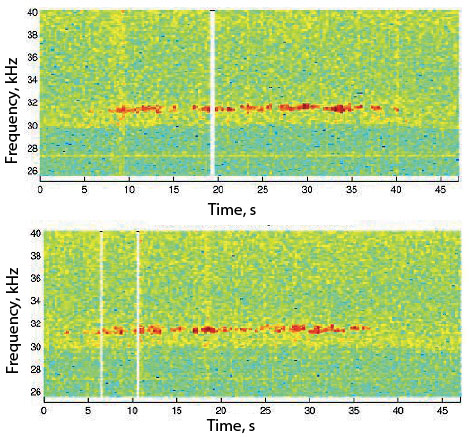Antenna diagnostics of radio signals and parameters of space plasma
 |
Frequency-angle filtration of the signals in the receiving antenna as the basis for new methods of diagnostics of plasma parameters, basing on the data of synchronous measurements provided by two Cluster II satellites. The intense narrow line at the 31.5 kHz frequency against the background of the noise spectrum corresponds to the local plasma frequency of electrons in the solar wind, whose signal increases sharply for the reception directions along the wind velocity
|
Antenna measurements of electromagnetic signals are one of the main methods of studying the ionospheric and magnetospheric plasma of the Earth, solar-wind plasma, and plasma sheaths of other planets, which are performed by using various space vehicles. The most interesting aspects of these measurements are registration and analysis of regular and noise emissions, as well as the development of active methods of diagnostics of the ionospheric-magnetospheric plasma.
The theory of resonance excitation of quasi-monochromatic pulse radiation, its propagation and antennas response during reception of such a pulse in media with anisotropic dispersion including moving and magnetized plasmas, has been developed. It was shown that when a resonance cone of waves is excited in magnetized plasma, a significant group delay and abnormal blurring (by several times) of the radiation pulse are observed already at short distances. It has been found that under such conditions, the effective length of the receiving dipole antenna can increase significantly (by tens and hundreds of times compared with the vacuum value) in the radiation reception directions, which correspond to the resonance wave excitation. According to the works of Yu. V. Chugunov's group, under these conditions a receiving antenna behaves as an angular-frequency filter that cuts off the receiving angle and frequency, which correspond to the resonance excitation of waves, from the space frequency spectrum of the incident wave.
The results of the theory made it possible to give a detail explanation to the data of wave experiments in the Earth's ionosphere (the two-point OEDIPUS-C experiment on emission and reception of a lower-hybrid wave pulse) and in the solar wind plasma (Cluster II satellite measurements), as well as to propose new methods for diagnostics of space plasma parameters.





